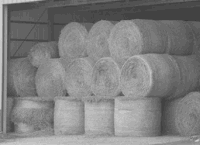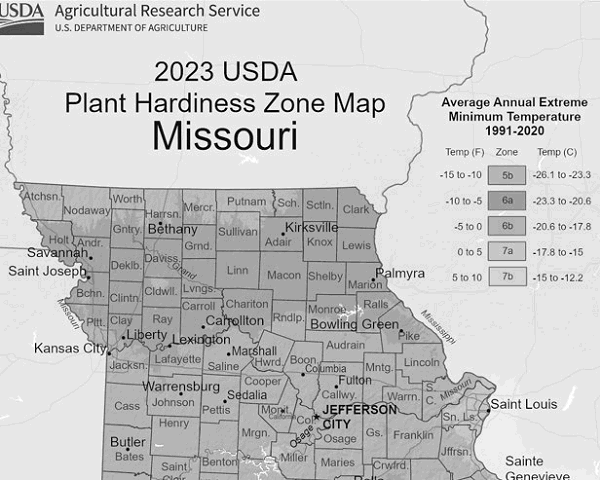

To send a message to an author, click on the author's name at the end of the article.
This Month in Ag Connection | Ag Connection - Other Issues Online

Livestock producers have a new tool available for buying and selling feedstuffs. The tool named Feedstuff Finder, is a new website encompassing many features including buying and selling hay and other feed products. The website was developed by University of Missouri Extension to help livestock producers and feed producers find each other easily. The listings are predominantly from Missouri and surrounding states.

The site is free to use, but to sell requires registration with basic information and creating a username and password. For those who cannot or do not want to register, visit a County Extension Center for assistance on listing. Sellers will need to provide prices, product information and location. Some of the products currently on the website include grass hay, alfalfa hay, baleage, soy hulls, distillers grains, corn gluten, corn silage, mealworm frass, and rice hulls.
With the ongoing drought and transportation issues, the website is gaining users quickly. Potential buyers can view available products on an easy-to-navigate map which includes product details and a delivery cost estimator.
The site has a help section including frequently asked questions for buyers and sellers, guidance on using the map, and filters. In addition, there is a place to ask questions to the developers of the website. Additional help tools, including instructional videos and in-person trainings, will be added.

MU Extension is collaborating with the Missouri Department of Agriculture and the MU Agricultural Electronic Bulletin Board to populate the directories and help users become familiar with Feedstuff Finder.
Funding for the Feedstuff Finder (feedstufffinder.org) was provided by the North Central Extension Risk Management Education Center and the USDA National Institute of Food and Agriculture under Award Number 2021-70027-34694. Feedstuff Finder went live in late November 2023.
Source: Mary Sobba, Ag Business Specialist
This Month in Ag Connection | Ag Connection - Other Issues Online
The map helps growers zero in on which vegetables and flowers will do best in different parts of the state, says University of Missouri Extension horticulturist Tamra Reall.
Perennial flowers and bushes can a big investment, Reall says. The map helps reduce the risk of choosing plants that might not survive local temperature extremes, she says.
USDA Agricultural Research Service's map is based on annual extreme minimum winter temperatures, says MU Extension climatologist Zack Leasor. The minimums are an average of the lower recorded temperature each year from 1991 to 2020.
The zone map is a standard for gardeners and growers to determine the right plant to grow in the right place at the right time of year. The map divides the U.S. into 13 zones based on extreme minimum winter temperature increments of 10 degrees Fahrenheit. Each zone is further divided into 5-degree half zones. Most seed packets and shrub or plant labels will indicate hardiness zone.
The new map breaks Missouri down into five hardiness zones: 5b, 6a, 6b, 7a and 7b. Most of the state falls into zones 6a (minus 10 F to minus 5 F) and 6b (minus 5 F to zero F).

The 2023 map incorporates data from 13,412 weather stations, up from 7,983 stations for the 2012 map, Leasor says. Compared to the 2012 map, Missouri shows considerable warming and a change in the hardiness zones, particularly in the northern and central parts of the state.
"Some of these changes reflect an observed trend of warming minimum temperatures in Missouri, but the inclusion of new station observations also influences the map by illustrating more localized patterns with better confidence," he says.
"When buying an expensive or sentimental plant, err on the side of caution and lean toward more cold-hardy options," Reall says. This means that if you live in an area that is zoned 6b, look for plants rated zone 5a or 5b, which can better tolerate extreme cold snaps, she says.
The map is available at https://planthardiness.ars.usda.gov. In addition to the national map, users can view and download maps for individual regions and states/territories.
The USDA Plant Hardiness Zone Map website now includes a "Tips for Growers" section, which has information about USDA research programs of interest to gardeners and others who grow and breed plants.
To see the map in color visit: https://tinyurl.com/HardyMap23.
Source: Linda Geist, MU Extension Media Team
This Month in Ag Connection | Ag Connection - Other Issues Online
Proper winter wheat fertility management can help to optimize growth and yield by promoting good growth, adequate tiller development, vigorous stem elongation and seed head development. Tillering primarily occurs during the fall between planting and dormancy and again for a month in the spring.
Nitrogen must be in adequate supply before jointing occurs. Phosphorus and potassium should be applied according to soil test and yield goals. Going into winter dormancy, an ideal number of tillers is 70-100 tillers per square foot. If your stand number falls below 70 tillers per square foot, a spring application of nitrogen at greenup is advisable. If tiller numbers are adequate, nitrogen should be applied as close to jointing as possible.
Applying spring nitrogen at greenup in a wheat stand which has adequate tillering will promote over production of tillers and excess growth leading to increased stand lodging and disease. Making split applications of nitrogen may be helpful in reducing nitrogen loss, particularly in fields with sandier soil. A good method to follow is applying 30 to 60 pounds of nitrogen at greenup and the rest just prior to jointing. The decision to use nitrification inhibitors should be based on weather conditions, application timing, and nitrogen source, particularly when top dressing urea, due to its relatively high volatilization rate once it makes soil contact. Total nitrogen application for the entire wheat growing season typically ranges from 90-150 pounds, with 90-100 pounds nitrogen applied in the spring being a good average. Variety, weather, and desired yield will drive nitrogen application rates.
The highest rate of total nutrient uptake, not just of nitrogen, is between jointing and flowering. For wheat following a corn crop, a tissue test is advisable to select the proper nitrogen fertilizer rate which should be applied. These tissue samples should be taken just before jointing, which occurs when there is a small hollow cavity at the base of the wheat stem.
For more information contact a Field Specialist in Agronomy at your local MU Extension Center.
Source: Nick Wesslak, Agronomy Specialist
This Month in Ag Connection | Ag Connection - Other Issues Online
The following list is for in-person training. Pre-registration is required at least one business day prior to the training. Each site has limited seating. The training is for farmers needing to obtain or renew a private pesticide applicator's license.
For questions call Valerie Tate (660)-895-5123 or Nick Wesslak (573) 769-2177.
Adair County - Feb. 5 @ 10 a.m.
Adair Extension office, 660-665-9866
Audrain County - Feb. 20 @ 6 p.m..
Courthouse Basement, 573-581-3231
Boone County - Jan. 22 @ 9 a.m., or 1 p.m.
MU Extension office, 573-445-9792
Callaway County - Jan. 17 @ 6 p.m.
Callaway Extension office, 573-642-0755
Carroll County - Jan. 29 @ 2 p.m.
Carroll Public Library, 660-542-1792
Chariton County - Feb. 26 @ 10 a.m.
Chariton County Courtroom, 660-288-3239
Clark County - Feb 8 @ 10 a.m. or 2 p.m.
FBC Kahoka Gymnasium, 660-727-3339
Cooper County - Feb 7 @ 12 noon MFA Training Ctr or 6 p.m. Pilot Grove Coop Shop,
660-882-5661
Grundy County - Jan. 22 @ 9 a.m.
NCMC Barton Farm, 660-895-5123
Howard County - Jan. 30 @ 1 p.m.
Howard Extension Center, 660-248-2272
Knox County - Feb 15 @ 10 a.m. or 2 p.m.
Greenley Research Center 660-397-2179
Lewis County - Feb. 7 @ 10 a.m. or 2 p.m.
Courthouse, 573-767-5273
Lincoln County - Jan. 25 @ 6 p.m.
Extension Center, 636-528-4613
Linn County - Feb. 26 @ 2 p.m.
MU Cornett Farm, 660-895-5123
Livingston County - Jan. 29 @ 9 a.m.
Mildred Litton Community Bldg, Litton Ctr., 660-646-0811
Macon County - Feb. 19 @ 10 a.m.
POET Mtg Room, 660-385-2173
Marion County - Feb. 20 @ 10 a.m. or 2 p.m.
Sesquicentennial Bldg, 660-385-2173
Mercer County - Jan. 22 @ 2 p.m.
Mercer Extension office, 660-895-5123
Moniteau County - Mar. 14 @ 6 p.m.
California H.S. Vo. Ag. Bldg, 573-378-5358
Monroe County - Feb. 13 @ 10 a.m. or 2 p.m.
Monroe Extension office, 660-327-4158
Montgomery County - Jan. 18 @ 6 p.m.
Montgomery City Library, 573-564-3733
Morgan County - Feb. 1 @ 9:30 a.m. Morgan County Seed or 2 p.m. Morgan Extension Center,
573-378-5358
Pike County - Feb. 8 @ 6 p.m.
Pike Extension Ctr/Courthouse Annex, 573-324-5464
Putnam County - Feb. 12 @ 2 p.m.
4-H Building, 660-947-2705
Ralls County - Feb. 1 @ 10 a.m. or 2 p.m.
Ralls Courthouse Basement, 573-985-3911
Randolph County - Feb. To be determined
Schuyler County - Feb. 5 @ 2 p.m.
Courthouse basement, 660-457-3469
Scotland County - Feb.6 @ 10 a.m. or 2 p.m.
Scotland County Fire Dept., 660-465-7255
Shelby County - Feb. 28 @ 10 a.m. or 2 p.m.
Shelby Extension office, 573-633-2640
Sullivan County - Feb. 12 @ 10 a.m.
City Hall Community Room, 660-895-5123

Publishing Information
Ag Connection is published monthly for Northeast and Central areas of Missouri producers and is supported by the University of Missouri Extension, the Missouri Agricultural Experiment Station, and the MU College of Agriculture, Food and Natural Resources. Managing Editor: Mary Sobba.